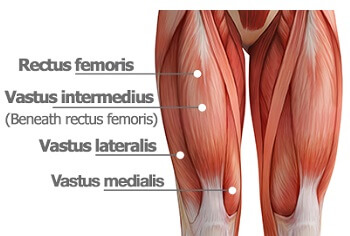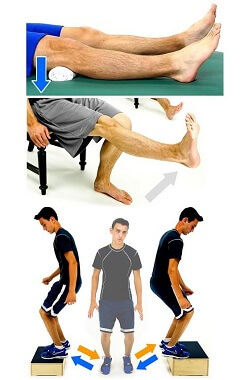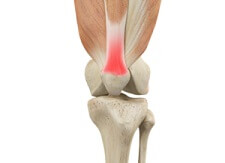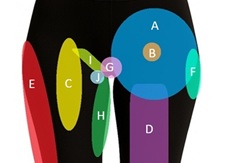- Home
- Common Knee Injuries
- Quads Strain
Pulled Quad Muscle
Written By: Chloe Wilson, BSc(Hons) Physiotherapy
Reviewed by: KPE Medical Review Board
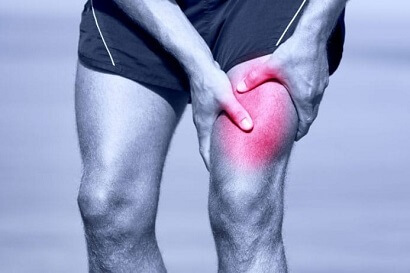
A pulled quad, aka quadriceps strain or torn quad, is where one or more of the quadriceps muscles on the front of the thigh are injured.
Most athletes will suffer from a pulled muscle at some point and it can side-line you from sports for anything from 1 week to 3 months.
Recovery from a quad strain may only take a week or two with rest, ice and gentle exercise, but with a more severe quadriceps injury it can take much longer.
People are often tempted to return to sports too soon following a quadriceps injury, but that makes you more prone to ongoing quadriceps pain and the risk of further injury.
What is A Quadriceps Strain?
The quads are a group of 4 muscles found on the front of the thigh, collectively known as the quadriceps femoris muscles.
Their primary function is to straighten the knee, and they are particularly important in jumping, sprinting and kicking movements.
Muscles are elastic tissues made up of thousands of tiny fibres. If too much force goes through the quads, then some of the muscle fibres tear. This may be from:
- Sudden Overstretching: when the muscle is quickly stretched beyond its elastic limit
- Sudden Overloading: when the muscle tries to do a quick, forceful movement that it doesn’t have the strength for, placing excessive force through the muscle
Thigh strains can affect any of the quads muscles, but most frequently it the Rectus Femoris muscle that is strained as it is the only quads muscle that runs across the hip as well as the knee, placing it under greater tension. A pulled quad is a common cause of pain above the knee.
What Causes A Quad Strain?
Quadriceps strains tend to affect athletes and sports enthusiasts, particularly in middle age.
Common causes and risk factors for a pulled quad include:
- Sports: especially football, soccer, basketball and rugby, all of which involve forceful contractions of the quads muscles
- Muscle Tightness: If the quads muscles are tight they are more likely to be over-stretched. Tightness in the hamstrings also increases the risk of a quadriceps strain
- Muscle Weakness: If the quads don’t have sufficient strength to perform the actions being asked of them then they are more likely to tear
- Muscle Fatigue: Muscles need not only good instantaneous strength for one-off actions such as kicking, but also good endurance so they keep their strength during a whole match or long sports session
- Insufficient Warm-Up: Warming up before running or playing sports helps to stretch the quads muscles out and gets them ready for action, activating neural pathways and reducing muscle viscosity, all of with reduce the risk of a pulled quad
- Forceful Knee Extension: Sudden acceleration e.g. sprinting, forceful kicking, jumping – taking off or landing or stopping suddenly are common causes of a torn quad
- Previous Muscle Tear: particularly if it didn’t fully heal
Pulled Quad Symptoms
Some people will feel pain immediately with a torn quad at the time of injury, while for other symptoms may come on over a few hours.
Typical symptoms of a pulled quad include:
- Quadriceps Pain: pain above the knee in the thigh – the location of the pain can help to identify which quads muscle is torn
- Popping Noise: There may be an audible “pop” or snapping sensation at the time of injury usually indicating a more severe tear or complete rupture
- Swelling & Bruising: There may be swelling above the knee and around the pulled quad that gets progressively worse over the first 24-48 hours
- Muscle Weakness: Decreased strength in the thigh muscles
- Difficulty With Functional Activities: such as going up and down stairs, walking and getting in and out of a chair
If your pain is more at the kneecap rather than in the muscle belly, it may be that you have quadriceps tendonitis rather than a pulled quad and if it is more towards the hip, you may have a hip flexor strain.
Torn Quad Classification
Quadriceps strains fall into three categories:
Grade 1 Quad Strain: Minor damage – less than 10% of fibres affected. Mild pain, minimal loss of strength and no palpable muscle defect
Grade 2 Quad Strain: Moderate damage – 10-90% of fibres affected. Moderate pain and loss of strength, small palpable muscle defect
Grade 3 Quad Strain: Severe damage – complete quadriceps rupture. Severe pain, complete loss of strength and palpable muscle defect

Pulled Quad Treatment
Treatment for a pulled quad muscle can be divided into two phases:
- The initial “acute” phase is the first few days following the injury where the focus is on reducing pain and inflammation and prevention from further injury.
- In the recovery phase, the focus is on restoring full strength, flexibility and function.
Acute Phase – First 3-5 days
Initial treatment for a pulled quad starts with:
- Rest: Appropriate rest prevents worsening or further injury. Avoid any activities that aggravate your quadriceps pain
- Ice: lowers intra-muscular temperature and decreases blood flow to the injured area both of which helps reduce swelling and speeds up healing. Ice can also help to reduce pain from a pulled quad – find out more in the ice treatment section
- Compression: Compression bandages, such as Tubigrip, help reduce blood flow and thus swelling in the thigh, and also provide gentle support
- Elevation: Resting with the leg raised high than the level of the heart helps to reduce thigh swelling following a quadriceps strain. This helps reduce pain and speeds up healing
- Crutches: With a grade 2 or 3 quad strain, crutches may be needed initially to allow rest and immobilization of the quads muscles
- NSAID’s: A short course of non-steroidal anti-inflammatories such as ibuprofen may be recommended by your doctor to help with pain control and swelling relief
Corticosteroids are not advised with a pulled quad as they can actually delay healing and weaken the injured muscle
Recovery Phase
The focus of the recovery phase with a pulled quad is regaining full strength and flexibility in the quads muscles. People are often scared to exercise after a quadriceps injury, but actually, exercises are a vital part of rehab following a pulled quad. Not only do they help to strengthen the muscles and restore function, they also help the muscle to heal in the right way.
Exercises help to ensure that as the muscle fibers start to knit back together, the right stresses and strains are put through them so that the fibers align properly to give full strength and elasticity, without which there is greater risk of future injury.
1. Strengthening Exercises
Stage 1: Isometric Exercises: This is when the muscle tightens but doesn’t change length e.g. clenching your glutes. Strengthens without the risk of further injury
Stage 2: Isotonic Exercises: This is where the you work the muscle whilst moving e.g. bending and straightening your elbow while holding a weight
Stage 3: Functional Exercises: Sport or activity specific exercises such as running, jumping and kicking
For a full range of exercises suitable for a pulled quad visit the quadriceps exercises section.
2. Stretches
Starting stretches too soon after a torn quad can actually make things worse. The torn muscle fibers need time to knit back together and stretching too soon will keep pulling them apart, a bit like when you pick off a scab.
Quadriceps stretches can be safely started once you can work the muscle against resistance without pain.
A simple test to see if you are ready to start quads stretches is:
- Sitting in a chair, cross the foot of your good leg over the foot of the affected leg
- Try and lift the affected leg forwards whilst resisting the movement with your good leg
- Only start stretches when you can do this without getting pain in your quads.
Start gently with quadriceps stretches, stopping before the point of pain. It can help to apply a heat pack to the quads for 15-20 minutes prior to doing stretches, but this should only be done after the first week or so to prevent further swelling. For full guidance visit the quadriceps stretches section.
You may also need to hamstring stretches too – try this quick test to see if your hamstrings are tight.
3. Physical Therapy
Your doctor may refer you for physical therapy following a pulled quad. This typically focuses on guidance with your home exercise programme.
They may also do some deep transverse friction massage and/or ultrasound therapy to help the healing muscle fibres to realign correctly.
Recovery Time
Recovery from a pulled quad may take anything from a week to 3 months, depending on the grade of injury.
Grade 1 Quad Strain: usually heals in 1-2 weeks with RICE and gentle exercises
Grade 2 Quad Strain: recovery usually takes around 4-6 weeks incorporating complete rest from aggravating activities, RICE, exercises and physical therapy
Grade 3 Quad Strain: may take up to 3 months to return to full function. It is vital not to return to sports until you are given the all clear by your physical therapist or doctor – you need to have regained full strength and flexibility in the quads first
Will I Need Surgery?
Most cases of quadriceps strains heal naturally, but with a severe grade 3 torn quad, surgery might be necessary if the tear is big enough that it is unlikely to heal by itself. You can find all about surgery, what it involves and how to make the best recovery in the ruptured quads section.
Preventing Quadriceps Strains
A pulled quad is a common sporting injury, but there are plenty of things you can do to reduce the risk of a quadriceps injury:
- Warm Up & Cool Down: Don’t be tempted to skip this. Warming up helps get the muscles ready for action and cooling down helps relieve any built up tension and lactic acid in the muscles
- Muscle Conditioning: Regularly do strengthening exercises for the thigh muscles to ensure good strength and endurance
- Regular Stretching: Stretching regularly helps to prevent muscle tightness in the quads and hamstrings, reducing the risk of injury. Visit the knee stretches section to find out how to safely and effectively stretch including our top exercises for stretching the quads and hamstrings
- Follow The 10% Rule: Suddenly increasing your activity levels makes you more prone to injury. Always gradually increase the amount of exercise – only increase the frequency, intensity e.g. weights, and duration by a maximum of 10% per week. This allows your muscles to build up sufficiently to take the extra strain
- Rehab Fully: Ensure you have completed your rehab programme and regained full function before returning to sports
Pulled Quad Summary
A pulled quad typically affects athletes and occurs suddenly.
Overstretching or overloading of the front thigh muscles can lead to a quadriceps injury whereas a hamstrings strain affects the muscles on the back of the thigh. If the pain is more towards the front of the hip, it is more likely to be a hip flexor strain.
Strengthening and stretching exercises help to both treat and prevent a quadriceps strain.
Most people recover from a pulled quad within a couple of weeks but more severe injuries can take up to 3 months.
A pulled quad is just one possible cause of pain above the knee and swelling above the knee.
You may also be interested in the following articles:
- Knee Cap Pain
- Pain Behind The Knee
- Front Knee Pain
- Outer Knee Pain
- Inner Knee Pain
- Inner Thigh Pain
- Knee Pain At Night
- How To Do Stairs With Knee Pain
Related Articles
Medical & Scientific References
- Diagnosis and management of quadriceps strains and contusions. J.M. Kary - Journal of Current Reviews in Musculoskeletal Medicine 2010
- Sprains & Strains. NHS UK
- Pulled Quad: How To Treat It and Bounce Back Quickly. Healthline 2016
Last Updated: May 14th, 2025
Next Review Due: May 14th, 2027
